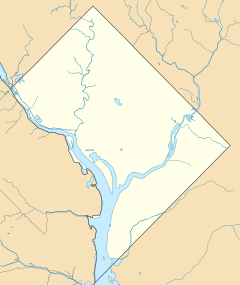
The United States Capitol, often called the Capitol or the Capitol Building, is the seat of the United States Congress, the legislative branch of the federal government. It is located on Capitol Hill at the eastern end of the National Mall in Washington, D.C. Although no longer at the geographic center of the national capital, the U.S. Capitol forms the origin point for the street-numbering system of the district as well as its four quadrants. Like the principal buildings of the executive and judicial branches, the Capitol is built in a neoclassical style and has a white exterior.

The Jefferson Memorial is a national memorial in Washington, D.C., built in honor of Thomas Jefferson, the principal author of the United States Declaration of Independence, a central intellectual force behind the American Revolution, a founder of the Democratic-Republican Party, and the nation's third president.
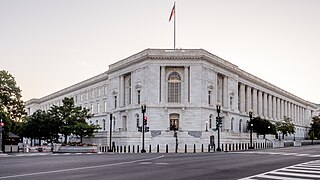
The Russell Senate Office Building is the oldest of the United States Senate office buildings. Designed in the Beaux-Arts architectural style, it was built from 1903 to 1908 and opened in 1909. It was named for former Senator Richard Russell Jr. from Georgia in 1972. It occupies a site north of the Capitol bounded by Constitution Avenue, First Street, Delaware Avenue, and C Street N.E.

The Cannon House Office Building, often called the "Old House Office Building", completed in 1908, is the oldest office building of the United States Congress in Washington, D.C. A significant example of the Beaux-Arts style of architecture, it occupies a site south of the United States Capitol bounded by Independence Avenue, First Street, New Jersey Avenue, and C Street S.E. In 1962 the building was named for former Speaker of the United States House of Representatives Joseph Gurney Cannon.

Ainsworth Rand Spofford was an American journalist, prolific writer and the sixth Librarian of Congress. He served as librarian from 1864 to 1897 under the administration of ten presidents. A great admirer of Benjamin Franklin, he wrote a twenty-one page introduction in Franklin's autobiography, which he edited and published.
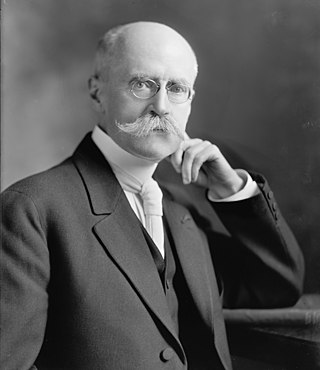
Edwin Howland Blashfield was an American painter and muralist, most known for painting the murals on the dome of the Library of Congress Main Reading Room in Washington, DC.

Jonathan Scott Hartley was an American sculptor.

Charles Henry Niehaus was an American sculptor.

Bela Lyon Pratt was an American sculptor from Connecticut.

The James Madison Memorial Building is one of three United States Capitol Complex buildings that house the Library of Congress. The building was constructed from 1971 to 1976, and serves as the official memorial to United States Founding Father and president James Madison. It is located between First and Second Streets SE on Independence Avenue, across for the main library Thomas Jefferson Building, in Washington, D.C. In addition to various book and multimedia collections, it houses the United States Copyright Office, which is under the administration of the Librarian of Congress.
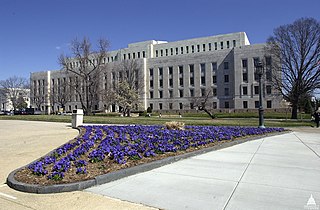
The John Adams Building is the second oldest of the buildings of the Library of Congress of the United States. Built in the 1930s, it is named for John Adams, the second president, who signed the law creating the Library of Congress in 1800. The building is in the Capitol Hill district of Washington D.C. next to the library's main building in the Capitol Complex. The Adams building opened to the public on April 5, 1939, and before being named for the president in 1980, was simply called The Annex building. It is designed in a restrained but very detailed Art Deco style and faced in white Georgia marble. It is located on Second Street SE between Independence Avenue and East Capitol Street in Washington, DC.
Norcross Brothers, Contractors and Builders was a nineteenth-century American construction company, especially noted for its work, mostly in stone, for the architectural firms of H.H. Richardson and McKim, Mead & White. The company was founded in 1864 by brothers James Atkinson Norcross (1831-1903) and Orlando Whitney Norcross (1839-1920). It won its first major contract in 1869, and is credited with having completed over 650 building projects.

Healy Hall is a National Historic Landmark and the flagship building of the main campus of Georgetown University in Washington, D.C., United States. Constructed between 1877 and 1879, the hall was designed by Paul J. Pelz and John L. Smithmeyer, both of whom also designed the Thomas Jefferson Building of the Library of Congress. The structure is named after Patrick Francis Healy, who was the President of Georgetown University at the time.
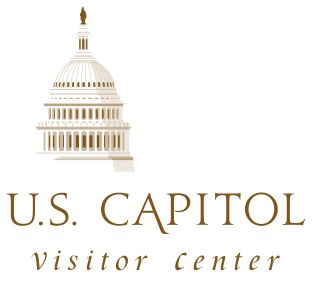
The United States Capitol Visitor Center (CVC) is a large underground addition to the United States Capitol complex which serves as a gathering point for up to 4,000 tourists and an expansion space for the U.S. Congress. It is located below the landscaped tree-shaded grounds of the East Front of the Capitol and its plaza, topped by a thick plastic / glass skylight on the surface, between the Capitol building and 1st Street East, towards the east. The complex contains 580,000 square feet (54,000 m2) of space below ground on three levels. The overall project's budget was $621 million dollars.
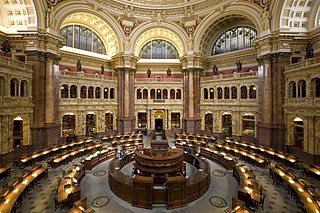
The Library of Congress (LOC) is a research library in Washington, D.C., serving as the library and research service for the United States Congress and the de facto national library of the United States. It also administers copyright law through the United States Copyright Office.

The Court of Neptune Fountain is a fountain adorned with bronze sculptures made by Roland Hinton Perry and Albert Weinert in the late 1890s. Jerome Connor may have assisted in their manufacture. The architects for the project, which was completed in 1898, included John L. Smithmeyer, Paul J. Pelz, and Edward Pearce Casey, while the founding was completed by the Henry-Bonnard Bronze Company. The fountain is located on the west side of the Thomas Jefferson Building, the main building for the Library of Congress in Washington, D.C. The project took three years to complete.

Paul Johannes Pelz was a German-American architect, best known as the main architect of the Library of Congress in Washington D.C.
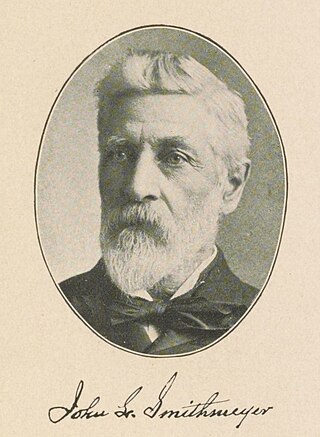
John L. Smithmeyer (1832–1908) was an American architect.

A statue of American Founding Father and U.S. President Thomas Jefferson by the French sculptor David d'Angers stands in the Capitol rotunda of the U.S. Congress. Jefferson is portrayed holding a copy of the United States Declaration of Independence, which he mainly drafted in 1776 as a member of the Committee of Five during the Second Continental Congress. The painted plaster model also stood in the chambers of the New York City Council.

Washington, D.C., the capital of the United States, has a unique and diverse architectural history. Encompassing government, monumental, commercial, and residential buildings, D.C. is home to some of the country's most famous and popular structures designed by some of the leading architects of their time. The popularity of the city's buildings is reflected in the findings of a 2007 poll of Americans by the American Institute of Architects, which found that six of the top 10 most popular U.S. structures were located in Washington, D.C. Overall, the poll found, 17 of the top 150 most popular structures were located in the capital.

